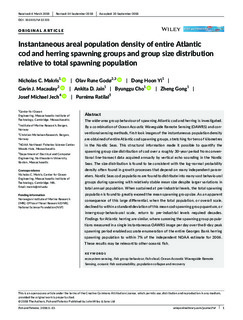| dc.description.abstract | The wide‐area group behaviour of spawning Atlantic cod and herring is investigated. By a combination of Ocean Acoustic Waveguide Remote Sensing (OAWRS) and conventional sensing methods, first‐look images of the instantaneous population density are obtained of entire Atlantic cod spawning groups, stretching for tens of kilometres in the Nordic Seas. This structural information made it possible to quantify the spawning group size distribution of cod over a roughly 30‐year period from conventional line‐transect data acquired annually by vertical echo sounding in the Nordic Seas. The size distribution is found to be consistent with the log‐normal probability density often found in growth processes that depend on many independent parameters. Nordic Seas cod populations are found to distribute into many vast behavioural groups during spawning with relatively stable mean size despite larger variations in total annual population. When sustained at pre‐industrial levels, the total spawning population is found to greatly exceed the mean spawning group size. As an apparent consequence of this large differential, when the total population, or overall scale, declined to within a standard deviation of this mean cod spawning group quantum, or inner‐group‐behavioural scale, return to pre‐industrial levels required decades. Findings for Atlantic herring are similar, where summing the spawning group populations measured in a single instantaneous OAWRS image per day over the 8‐day peak spawning period enabled accurate enumeration of the entire Georges Bank herring spawning population to within 7% of the independent NOAA estimate for 2006. These results may be relevant to other oceanic fish. | nb_NO |
